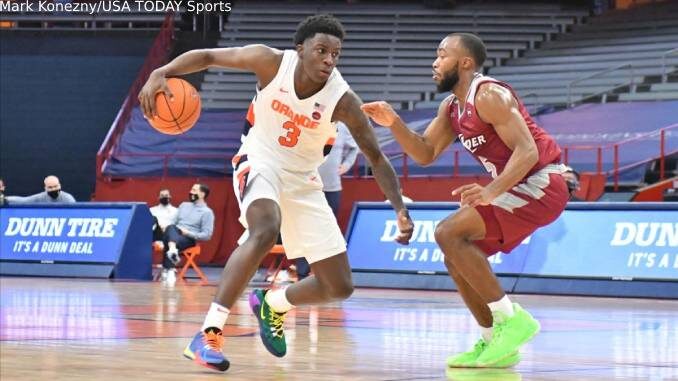
It seems that the only thing that will even temporarily end the “play Kadary Richmond” drumbeat coming from the Syracuse fanbase will be the end of the 2020-2021 season. Of course, it will not completely go away, but into some sort of hibernation until next fall.
Richmond is clearly the best defender, creator, and passer at guard on the roster. The question then is who best complements Richmond and should join him on the floor at guard.
Some minor headache-inducing mathematics and spreadsheet construction could point to the answer. Fortunately, the need for weekday content following the short notice cancellation of the SU-Louisville game on Wednesday night created the window of opportunity to get that headache.
Here’s what the shooting numbers say, as both Buddy Boeheim and Joe Girard III are essentially spot-up shooters when sharing the floor with Richmond and the other is on the bench:
- Boeheim with Richmond – 15 games, 129:55 of playing time (8:40 per game), shooting 19-of-62 from the field (30.6 percent) and 5-of-29 from three (17.2 percent)
- Girard with Richmond – 18 games, 140:23 of playing time (7:48 per game), shooting 21-of-53 from the field (39.6 percent) and 11-of-37 from three (29.7 percent)
Based on the shooting percentages alone, it certainly seems like Richmond should be paired with Girard more often than with Boeheim. Girard’s numbers are fairly close to being in line with his season long stats of 36.9 percent on field goals and 34.0 percent on threes. Boeheim’s are even worse than his disappointing overall numbers of 38.3 percent overall and 31.4 percent from long range.
Girard being able to play ten minutes a game as a spot-up shooter without needing to have the ball in his hands plays to his shooting ability. Deploying him behind the arc, squared up and ready to fire, makes sense. It also alleviates a little of his workload by taking both the ball and creator duties off his plate for a few minutes a game, saving him just a little bit.
If it feels like those playing time numbers do not align with what has been happening on the court recently, namely, seeing Boeheim on the floor with Richmond a lot, that suspicion is correct. Richmond started the second through fourth games of the season when Boeheim was held out due to COVID-related reasons. In fact, just over 84 minutes of playing time for a Girard-Richmond backcourt came during those three games.
The odd thing is that crash course back in early December appears to have paid dividends, despite Girard shooting poorly in two of those three early games when paired with Richmond. Since Boeheim’s return from COVID-related reasons, Girard has shot very well while sharing the floor with Richmond. In just over 54 minutes with the two of them on the floor together and Boeheim on the sideline, Girard is 14-for-27 (51.9 percent) from the field and 6-of-17 (35.3 percent) on threes.
Playing all three together is where both Boeheim and Girard have both shined on offense with Richmond in a very small sample. The trio has shared the court for 55:14 this season and both shooters have flourished in that time. Boeheim is 7-for-15 (46.7 percent) during those limited minutes and 5-of-9 (55.6 percent) from long range while Girard is 9-of-18 overall (50.0 percent) and 5-for-11 (45.5 percent) on triples.
» Related: Breaking down Syracuse’s win over Boston College
That perimeter punch should be unleashed on a limited basis, though, possibly even treating lineups with that trio as “break glass in case of emergency” due to its limitations on the defensive end of the floor. Richmond has to play on the top line of the defense in this scenario to play to his strengths as a disrupter of passing lanes and Girard’s height anchors him to the top line. Boeheim is a poor rebounder and having him play the backline of the zone only exacerbates that problem.
Playing all three together should be limited to advantageous times only, namely when facing a team without great height and/or against reserve units where they are less likely to be exposed on the defensive end. The three could also be deployed together if the team is in a deep hole, possibly as part of their pressing unit, although those same defensive limitations would likely limit the upside of the press.
For more Syracuse coverage, Like our Facebook page, follow us @TheJuiceOnline and listen to our podcast.

